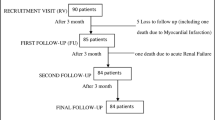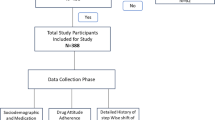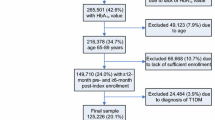Abstract
Study was undertaken to identify patterns of antidiabetic drugs prescribing in established type 2 diabetes mellitus. Patients with established T2DM who attended the endocrinology Outpatient Clinic in Postgraduate Institute of Medical Education and Research, Chandigarh, India were evaluated for social, demographical and clinical variables and medications. 1185 established T2DM patients were assessed. Metformin was the most commonly prescribed drug [827 (70 %)], followed by insulin [627 (53 %)], sulfonylureas [520 (44 %)], and pioglitazone [329 (28 %)]. The most frequently prescribed monotherapy was insulin [214 (62 %)], followed by metformin in 81 (23 %), sulfonylurea in 49 (14 %) and pioglitazone in 4 (1 %) patients. 704 (59 %) treated patients had uncontrolled hyperglycemia. Family history (OR 1.76, 95%CI 1.18, 2.64), diabetes duration (OR 2.62, 95 % CI 2.05, 3.36), HbA1c (OR 1.25, 95%CI 1.01, 1.50), neuropathy(OR 1.57, 95 % CI, 1.14, 2.2), nephropathy(OR 1.77, 95 % CI 1.40, 2.24), retinopathy (OR 1.97, 95 % CI 1.63, 2.40), coronary arterial disease (CAD) (OR 1.57, 95 % CI, 1.14, 2.2) and diabetic foot (OR 1.62, 95 % CI 1.12, 2.40) were all significantly associated with insulin therapy. Obese and overweight patients were prescribed oral antidiabetic drugs. Medication use was consistent with practice guidelines in T2DM, even though the outcome did not reach the goal.
Similar content being viewed by others
References
Turnbull F, Neal B, Algert C, Chalmers J, Chapman N, Cutler J, et al. Effects of different blood pressure-lowering regimens on major cardiovascular events in individuals with and without diabetes mellitus: results of prospectively designed overviews of randomized trials. Arch Intern Med. 2005;165:1410–9.
Estacio RO, Jeffers BW, Hiatt WR, Biggerstaff SL, Gifford N, Schrier RW. The effect of nisoldipine as compared with enalapril on cardiovascular outcomes in patients with non-insulin-dependent diabetes and hypertension. N Engl J Med. 1998;338:645–52.
Stratton IM, Adler AI, Neil HA, Matthews DR, Manley SE, Cull CA, et al. Association of glycaemia with macrovascular and microvascular complications of type 2 diabetes (UKPDS 35): prospective observational study. BMJ. 2000;321:405–12.
Davis TM, Cull CA, Holman RR. Relationship between ethnicity and glycemic control, lipid profiles, and blood pressure during the first 9 years of type 2 diabetes: U.K. Prospective Diabetes Study (UKPDS 55). Diabetes Care. 2001;24:1167–74.
Gerstein HC, Miller ME, Byington RP, Goff Jr DC, Bigger JT, Buse JB, et al. Effects of intensive glucose lowering in type 2 diabetes. N Engl J Med. 2008;358:2545–59.
Holman RR, Paul SK, Bethel MA, Matthews DR, Neil HA. 10-year follow-up of intensive glucose control in type 2 diabetes. N Engl J Med. 2008;359:1577–89.
Patel A, MacMahon S, Chalmers J, Neal B, Billot L, Woodward M, et al. Intensive blood glucose control and vascular outcomes in patients with type 2 diabetes. N Engl J Med. 2008;358:2560–72.
Gaede P, Lund-Andersen H, Parving HH, Pedersen O. Effect of a multifactorial intervention on mortality in type 2 diabetes. N Engl J Med. 2008;358:580–91.
Cobitz AR, Ambery P. Medical management of hyperglycemia in type 2 diabetes: a consensus algorithm for the initiation and adjustment of therapy: a consensus statement of the American Diabetes Association and the European Association for the Study of Diabetes. Response to Nathan et al. Diabetes Care. 2009;32:e58.
Sibal L, Home PD. Management of type 2 diabetes: NICE guidelines. Clin Med. 2009;9:353–7.
Indian diabetes guidelines. J Assoc Physicians India. 2002;50:295.
Bero LA, Grilli R, Grimshaw JM, Harvey E, Oxman AD, Thomson MA. Closing the gap between research and practice: an overview of systematic reviews of interventions to promote the implementation of research findings. The Cochrane Effective Practice and Organization of Care Review Group. BMJ. 1998;317:465–8.
Grol R, Grimshaw J. From best evidence to best practice: effective implementation of change in patients’ care. Lancet. 2003;362:1225–30.
Trinder P. Determination of blood glucose using an oxidase-peroxidase system with a non-carcinogenic chromogen. J Clin Pathol. 1969;22:158–61.
Allain CC, Poon LS, Chan CS, Richmond W, Fu PC. Enzymatic determination of total serum cholesterol. Clin Chem. 1974;20:470–5.
Fossati P, Prencipe L. Serum triglycerides determined colorimetrically with an enzyme that produces hydrogen peroxide. Clin Chem. 1982;28:2077–80.
Grading diabetic retinopathy from stereoscopic color fundus photographs--an extension of the modified Airlie House classification. ETDRS report number 10. Early Treatment Diabetic Retinopathy Study Research Group. Ophthalmology. 1991;98:786–806.
Hippisley-Cox J, Pringle M. Prevalence, care, and outcomes for patients with diet-controlled diabetes in general practice: cross sectional survey. Lancet. 2004;364:423–8.
Secnik K, Yurgin N, Lage MJ, McDonald-Everett C. Patient characteristics, glycemic control, and the use of antidiabetic agents among individuals diagnosed with type 2 diabetes: Evidence from the UK. . ISPOR European Meeting; 2005 October 2005.
Yurgin N, Secnik K, Lage MJ, editor. Type 2 diabetes in Germany: Prevalence and medication use. ISPOR European Meeting, October 2005.
Wysowski DK, Armstrong G, Governale L. Rapid increase in the use of oral antidiabetic drugs in the United States, 1990–2001. Diabetes Care. 2003;26:1852–5.
Walley T, Folino-Gallo P, Stephens P, Van Ganse E. Trends in prescribing and utilization of statins and other lipid lowering drugs across Europe 1997–2003. Br J Clin Pharmacol. 2005;60:543–51.
Lusignan S, Sismanidis C, Carey IM, DeWilde S, Richards N, Cook DG. Trends in the prevalence and management of diagnosed type 2 diabetes 1994–2001 in England and Wales. BMC Fam Pract. 2005;6:13.
Cohen FJ, Neslusan CA, Conklin JE, Song X. Recent antihyperglycemic prescribing trends for US privately insured patients with type 2 diabetes. Diabetes Care. 2003;26:1847–51.
Bailey CJ. Metformin: a multitasking medication. Diab Vasc Dis Res. 2008;5:156.
Evans A, Krentz AJ. Benefits and risks of transfer from oral agents to insulin in type 2 diabetes mellitus. Drug Saf. 1999;21:7–22.
Lund SS, Vaag AA. Intensive glycemic control and the prevention of cardiovascular events: implications of the ACCORD, ADVANCE, and VA diabetes trials: a position statement of the American Diabetes Association and a scientific statement of the American College of Cardiology Foundation and the American Heart Association: response to Skyler et al. Diabetes Care. 2009;32:e90–1.
Nathan DM, Cleary PA, Backlund JY, Genuth SM, Lachin JM, Orchard TJ, et al. Intensive diabetes treatment and cardiovascular disease in patients with type 1 diabetes. N Engl J Med. 2005;353:2643–53.
UK Prospective Diabetes Study (UKPDS) Group. Intensive blood-glucose control with sulphonylureas or insulin compared with conventional treatment and risk of complications in patients with type 2 diabetes (UKPDS 33). Lancet. 1998;352:837–53.
Kooy A, de Jager J, Lehert P, Bets D, Wulffele MG, Donker AJ, et al. Long-term effects of metformin on metabolism and microvascular and macrovascular disease in patients with type 2 diabetes mellitus. Arch Intern Med. 2009;169:616–25.
Johnson JA, Majumdar SR, Simpson SH, Toth EL. Decreased mortality associated with the use of metformin compared with sulfonylurea monotherapy in type 2 diabetes. Diabetes Care. 2002;25:2244–8.
Yki-Jarvinen H, Ryysy L, Nikkila K, Tulokas T, Vanamo R, Heikkila M. Comparison of bedtime insulin regimens in patients with type 2 diabetes mellitus. A randomized, controlled trial. Ann Intern Med. 1999;130:389–96.
Mudaliar S, Edelman SV. Insulin therapy in type 2 diabetes. Endocrinol Metab Clin North Am. 2001;30:935–82.
Shah BR, Hux JE, Laupacis A, Zinman B, van Walraven C. Clinical inertia in response to inadequate glycemic control: do specialists differ from primary care physicians? Diabetes Care. 2005;28:600–6.
Conflicts of interest
None
Author information
Authors and Affiliations
Corresponding author
Rights and permissions
About this article
Cite this article
Dhanaraj, E., Raval, A.D., Yadav, R. et al. Prescribing pattern of antidiabetic drugs and achievement of glycemic control in T2DM patients tertiary care hospital in North India. Int J Diabetes Dev Ctries 33, 140–146 (2013). https://doi.org/10.1007/s13410-013-0123-5
Received:
Accepted:
Published:
Issue Date:
DOI: https://doi.org/10.1007/s13410-013-0123-5




